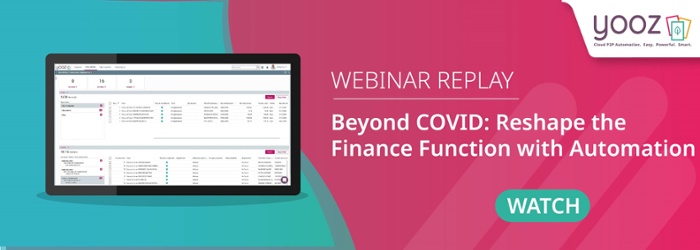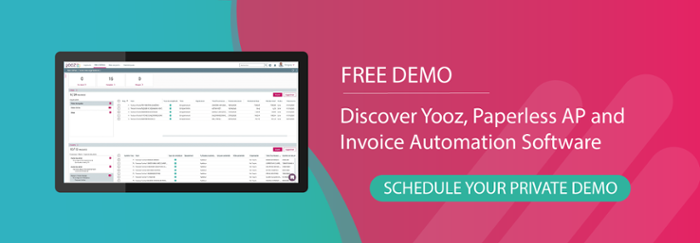“Caught flat-footed.” That’s how analysts at Levvel Research describe companies that didn’t have plans for accounts payable automation in place when the pandemic threw a giant wrench into their business in early 2020. Staff was scattered, teams miscommunicated, invoices piled up, payment deadlines were missed, late fees accumulated, vendors got antsy, and cash flow became even more of an issue.
In either case not a good spot to weather a major disruption nor a good starting point to embark on digital transformation. Unless that is, your organization was among those that had already begun to improve accounts payable efficiency to become more productive and competitive.
Companies that spend sufficient time and resources to figure out the best Accounts Payable (AP) solution for their business can discover and unlock the benefits of end-to-end automation, from purchase to payment. They score by gaining the ability to approve and pay invoices with unmatched speed, savings, and security.
That said, are you ready to automate?
How to Develop an AP Automation Business Case
Let’s walk through the process to gather information for and to evaluate the AP automation business case process step by step. First, the good news. According to Levvel’s most recent “2021 Payables Insight Report”, the pandemic has significantly sped up the modernization trend among AP departments. Eight out of ten respondents told Levvel they are interested in a third-party AP automation tool, and many did indeed implement such software, driven by the realization of how much it adds to their bottom line and future competitiveness.
Choosing a platform that’s custom-built for purchase-to-pay automation beats other stopgap measures, among them manual processes that rely on spreadsheets and other documents. Or by outsourcing tasks. It even beats using the limited capabilities of ERP packages which are more generalist in nature and therefore lack the functionality and deep understanding of the AP workflow.
The 4 Things To Demand From AP Automation
A modern AP automation system must excel at several things:
- Be a cloud-based tool that includes the latest in robotic process automation and machine learning,
- Require as little human intervention as possible, also known as straight-through processing,
- Reliably capture and understand an invoice to extract all relevant info and route it for approval, and
- Take the process all the way to payment and reconciliation with a company’s financial software.
The core features of AP automation have been around for a while, Levvel’s researchers point out, but software capabilities keep growing as adoption spreads. Yooz is one platform that constantly expands its capabilities so companies can save time and money as well as accumulate valuable financial intelligence to turn their AP function into a strategic asset year after year.
3 Steps to Identify the Ideal Solution
Identifying the ideal solution starts with gathering data, in this case making an assessment that walks the organization through its pre-automation process and then maps out what it will look like post-implementation. Levvel emphasizes that this before and after the evaluation is crucial to building a strong business case for AP automation.
This is because such as assessment will help answer questions such as whether or not to automate, what features to prioritize, how to eliminate inefficiencies, and how to define a future vision for the AP function. “Skipping this step,” the market researchers warn, “can result in software that tries to cover up a poor process, which can create more frustration and inefficiency than prior to implementation.”
Here are the three steps they recommend that an organization follow:
- Quantify invoice volume, supplier count, and average document touches,
- Evaluate the invoicing process across the entire organization, and
- Think into the future.
Mapping Invoices, Vendors and Workflows
First, identify the total number of invoices and map them by format, locations and spend type. It also helps to group suppliers to identify those that send invoices in unstructured formats and target them to transition to a structured invoice format.
- Once up and running, Yooz will cut processing and cycle time by 80 percent. The new YoozPay module speeds up the process even more, allowing vendor onboarding with a single email address and one click to receive instant payments.
The second aspect of the current state assessment involves counting average document touches to reduce steps in the approval process. Along the way, an organization can also figure out the proper role-based access to invoices and design the optimal approval workflow.
- Yooz automatically captures and reviews invoices, flags exceptions before routing them for approval. Authorized employees can sign off on an invoice from anywhere, removing another speed bump.
Next comes an evaluation of the invoice process for the entire organization. Ideally, Levvel found, invoicing should be handled consistently across locations and departments. It gets confusing fast when companies are part of a larger entity, have a global footprint or work in an industry with unique invoice formats. AP automation software worth its salt must be able to handle all that.
- Yooz has decades of experience capturing and reading more than 100 million invoices from one million-plus vendors in 30 plus countries, so there are few things that will stump it.
- Not a problem for Yooz, which has plug-and-play integration with more than 250 ERP and financial software packages. A handful of major payment gateways are already integrated with Yooz, and the new YoozPay module gives AP staff a single, consistent web interface to do it all, from creating a purchase order to scheduling and paying an invoice.
The Business Case For AP Automation
Finally, organizations have to think into the future. Current AP automation needs are just a snapshot but not an insurance policy against disruptions brought on by digital transformation. A company may grow, often expand its geographical footprint, so the ideal AP automation platform should be able to grow with you.
One useful exercise to project the future state involves calculating the return on investment (ROI) from software implementation, Levvel’s experts advise, ranging from discount capture to labor cost optimization:
“AP departments can reallocate back-office resources to focus on more strategic tasks in other parts of finance and supplier management. This results in a cost-per-invoice decrease, increased efficiency, and a department that does not need to expand headcount as volume increases. The final savings are from process improvement, which will vary from department to department… Additionally, with advanced AP software features, instances of fraud decrease, and audits become easier, which saves organizations time and money spent dedicated to these processes.”
- Yooz checks the boxes on all of those important opportunities for tangible and sustained savings, providing ROI almost from the start.
As a cloud-based platform it is up and running in an hour or less, correctly capturing 80% of invoices without any prior configuration. As a result, the processing cost per invoice drops from $0.95 to $0.25.
You’ll never miss a payment deadline, capture all available early-pay discounts. What’s more, the rate of exceptions goes down by almost two-thirds, weeding out potentially expensive errors and fraudulent payments. Additionally, businesses that use a virtual credit card with YoozPay can tap a new recurring revenue stream thanks to cash-back from every invoice paid.
All in all, that’s a pretty compelling case for AP automation. And an exercise worth running in any organization.
FAQs
How can AP automation specifically reduce processing costs and time for our accounts payable operations?
What are the integration capabilities of AP automation with our existing ERP or financial management systems?
Can you provide examples or case studies of businesses in our industry that have successfully implemented AP automation and the benefits they achieved?
How does AP automation support compliance and improve accuracy in financial reporting and audits?






